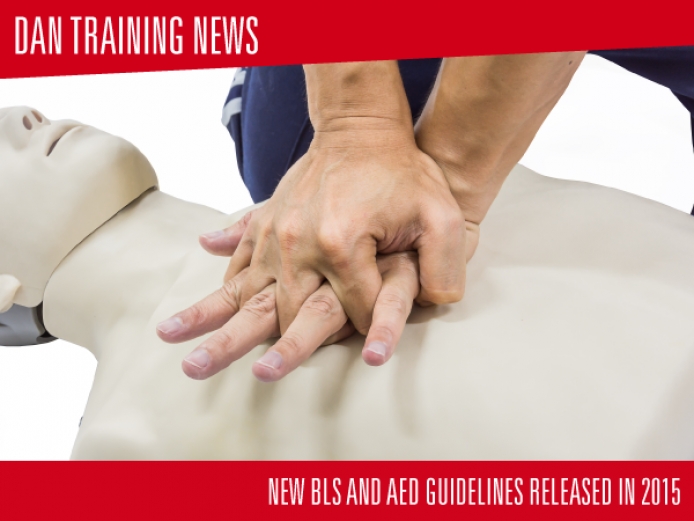Making sure that rescuers are prepared to provide care in an emergency is the goal of every first aid program; DAN's training programs are no exception. Recently, the European Resuscitation Council (ERC) and the International Liaison Committee on Resuscitation (ILCOR) released a new set of science-based guideline changes to basic life support. These changes are designed to help first responders be more confident when they encounter an emergency. They should also make the response and care given more effective.
Although the changes made by the ERC are minor and in many parts they only confirm/reinforce the 2010 guidelines, DAN Medical and Training staff will review these new guidelines and every DAN course to determine how best to implement these changes. DAN will revise all of its training programs by the end of the year 2015 to accommodate and reflect these changes.
The main changes and reinforcements are:
Adult BLS sequence
Calling for additional help (if required) is incorporated in the alerting emergency services step.
Chest Compressions
Rescuers should deliver these compressions at a rate of 100-120 compressions per minute. CPR providers should ensure chest compressions of adequate depth (at least 5 cm but no more than 6 cm). High-quality CPR remains essential to improving out come. This emphasis on the quality of the chest compressions is new, although the rate had been in place since 2010. You should allow the chest to recoil completely after each compression and your compression and release times should be the same. When delivering compressions, you should also work to minimise interruptions.
Compression to ventilation ratio
In all cases lay rescuers should deliver 30 chest compressions followed by two breaths. This applies to adults, children and infants.
The adult CPR sequence can be used safely in children who are unresponsive and not breathing normally. Chest compression depths in children should be at least one third of the depth of the chest (for infants that is 4 cm, for children 5 cm).
For ease of teaching and retention, laypeople should be taught that the adult sequence may also be used for children who are not responsive and not breathing normally.
The following minor modifications to the adult sequence will make it even more suitable for use in children:
Give 5 initial rescue breaths before starting chest compressions
Give CPR for 1 min before going for help in the unlikely event the CPR provider is alone
Compress the chest by at least one third of its depth; use 2 fingers for an infant under one year; use 1 or 2 hands for a child over 1 year as needed to achieve an adequate depth of compression
The same modifications of 5 initial breaths and 1 min of CPR by the lone CPR provider before getting help, may improve outcome for victims of drowning. This modification should be taught only to those who have a specific duty of care to potential drowning victims (e.g. lifeguards).
Signs of circulation
Do not check for signs of circulation. Assume a person who has stopped breathing is also in full arrest. The only exceptions to this are when providing care for children, where rescuers look for signs of life after 5 initial rescue breaths.
Rescue breaths
Each rescue breath should be delivered in about 1 second. Previously, in providing care for children, the recommendation was 1 to 1,5 seconds. Now the duration of delivering a breath coincides with adult practice. Each breath should make the chest rise and rescuers should be able to see that rise. Rescuers should also avoid giving breaths that are too rapid or too forceful.
DAN has also determined that rescue breathing with an oronasal rescucitation mask is important when caring for injured divers and swimmers.
As such, rescue breathing with oronasal rescusitation mask will remain in DAN courses. DAN courses represent a step above basic lay provider training.
AED use
AEDs make it possible to defibrillate many minutes before professional help arrives. AEDs are safe and effective when used by lay rescuer. It's critically important that BLS Providers focus on following the voice prompts immediately when they are spoken, in particular resuming CPR as soon as instructed, and minimising interruptions in chest compression.
CPR before defibrillation - Continue CPR while a defibrillator or AED is being brought on-site and applied, but defibrillation should not be delayed any longer.
Interval between rhythm checks - Pause chest compressions every 2 min to assess the cardiac rhythm (AED).
Voice prompts - It is critically important that CPR providers pay attention to AED voice prompts and follow them without any delay.
The 2015 guidelines also reaffirmed that standard AEDs are suitable for use in children older than 8 years. For children between 1 and 8 years use paediatric pads, together with an attenuator or a paediatric mode if available.
However, if the AED available is only able to deliver an adult dose, it can still be used. When you witness the sudden collapse of a child, you should use the AED immediately. If the collapse was not witnessed, you should provide 1 minute of CPR prior to using the AED.
Other changes to Lay Rescuer BLS that will affect DAN courses are:
The critical importance of the interactions between the emergency medical dispatcher, the bystander who provides CPR and the timely deployment of an AED.
The bystander who is trained and able should assess the collapsed victim rapidly to determine if the victim is unresponsive and not breathing normally and then immediately alert the emergency services.
Apply direct pressure, with or without a dressing, to control external bleeding where possible. Where bleeding cannot be controlled by direct pressure it may be possible to control bleeding by the use of a haemostatic dressing or a tourniquet. Training is required to ensure the safe and effective application of a tourniquet.










